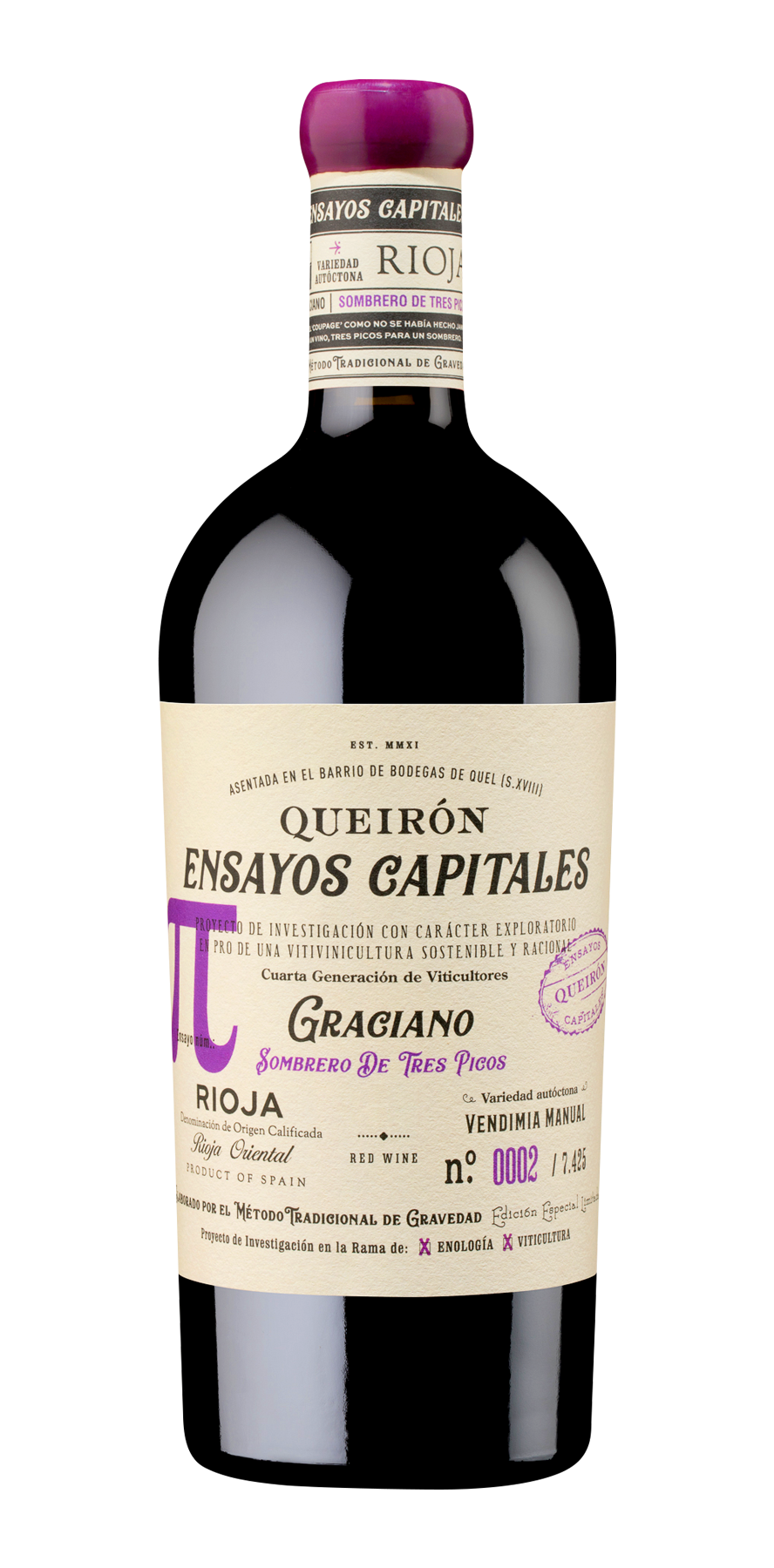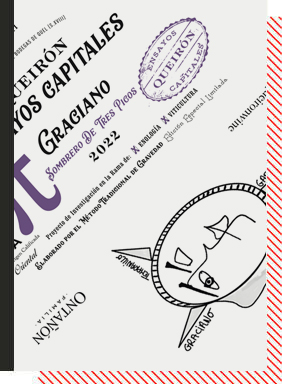Ensayos
Capitales
Nºπ (Pi)
Sombrero de tres picos
Graciano, tempranillo, garnacha / 2022
(A Three-cornered Hat)
In this wine we tried out a ‘coupage’ that had never been made before: three caps (*) for one wine, a three-cornered hat.
To start off: Why have we given it the number π (Pi)?
The Ensayos Capitales de Queirón project is one of the small indulgences in life that a bodega can permit itself. A pleasure and a challenge that offers the chance every now and again to create a wine which departs from the standard catalogue, from the established or preconceived styles, which allows us to experiment on the margins of knowledge, whether in the realm of viticulture or that of oenology. Ensayos Capitales is risky and fun, so therefore the purest essence of our bodega, because it gives us an opportunity and forces us always to be aware of everything, what’s new and also remembering the past. History and innovation. Tradition and modernity. Unshackled freedom which began with the first chapter, a Graciano with no added sulphites in either the vineyard of the winemaking process. We devoted the second episode to tempranillo blanco, a grape variety which is exclusive to Rioja, that we made with its skins and finished off in an earthenware vessel. And the third was the pursuit of aromatic concentration and colour using a very old method, long abandoned in Rioja, and known as asoleo, or sun-drying the grapes after picking. The three wines were short-lived. All three have sold out. Ensayos Capitales are like ripples in the water that leave a mark on the memory and in the spirit but which are born with no intention of surviving. They are transformative ideas which themselves are transformed, thoughts that are sustained during the time they linger in the memory and by new wines which have been inspired by their innovative character.
This Ensayo Capitales nº π is different to all the others just as they are all different to this one. And we have called it π because it is an iconic number, irrational and yet at the same time, mysterious, expressing the relationship between the length of a circumference and its diameter in the geometry of Euclid, a Greek mathematician who sketched out his thoughts by assuming a small set of axioms or tenets and then, from these, was able to deduce a lot more propositions (theorems). A bit like the philosophy of the Ensayos Capitales project. We take different ideas and histories, we study them, we recreate them and allow our imagination free rein to sketch out new proposals in the world of wine imagination.
One of the keys of this Ensayo is that we rethink one of the most important axioms or tenets in the history of the world of wine: the ‘coupage’ and bring it back to the world in our own way, by trying to deduce a new formula for winemaking from the Ensayo which until now was practically unheard of.
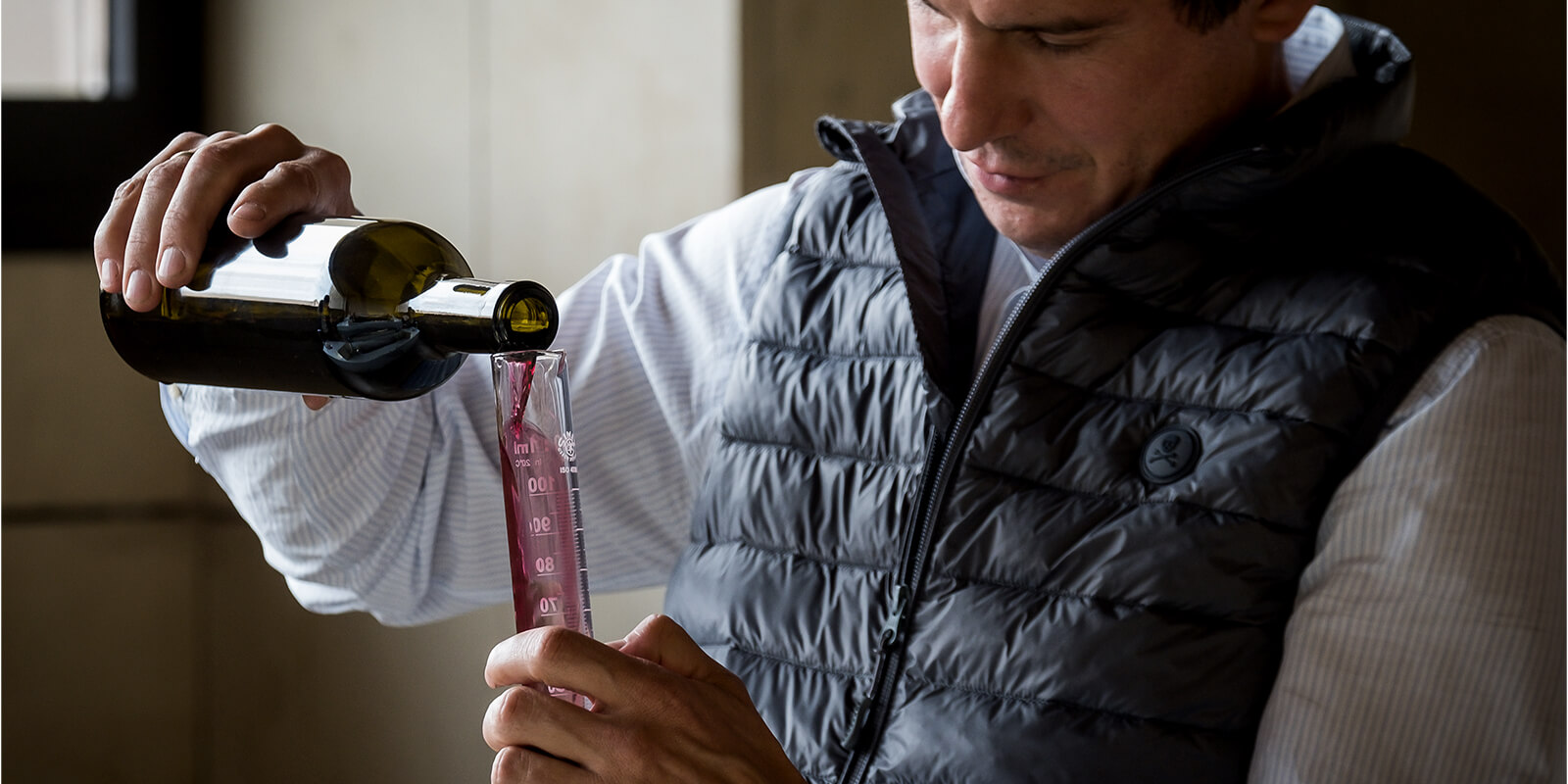
Rubén Pérez Cuevas, winemaker at Queirón.
Getting down to business:
What do we mean by “coupage”?
The term ‘coupage’ is a French word and refers to the process or technique consisting in blending together different wines, with different characteristics and/or grape varieties, in order to achieve the final product. Here we are facing the true art of blending in which the oenologist, or the “master blender” displays their wisdom by combining different wines to obtain a wine which is superior to each of the wines involved in the mix on their own. Through this ‘coupage’ more complex wines are obtained, because they are enriched by the nuances that are offered by each of the different varieties that come into play, and the deficiencies of some can be corrected by the virtues of others.
Mix, blend, coupage or assemblage are technical winemaking terms which are related to the development of a predominant technique in the history of Rioja wines. Our region has traditionally been regarded as an area of blended wines, a model which began with the influence of the way they made wine in the great Bordeaux Chateaux, which arrived after the phylloxera crisis and established itself in this blessed region of the Ebro Valley.
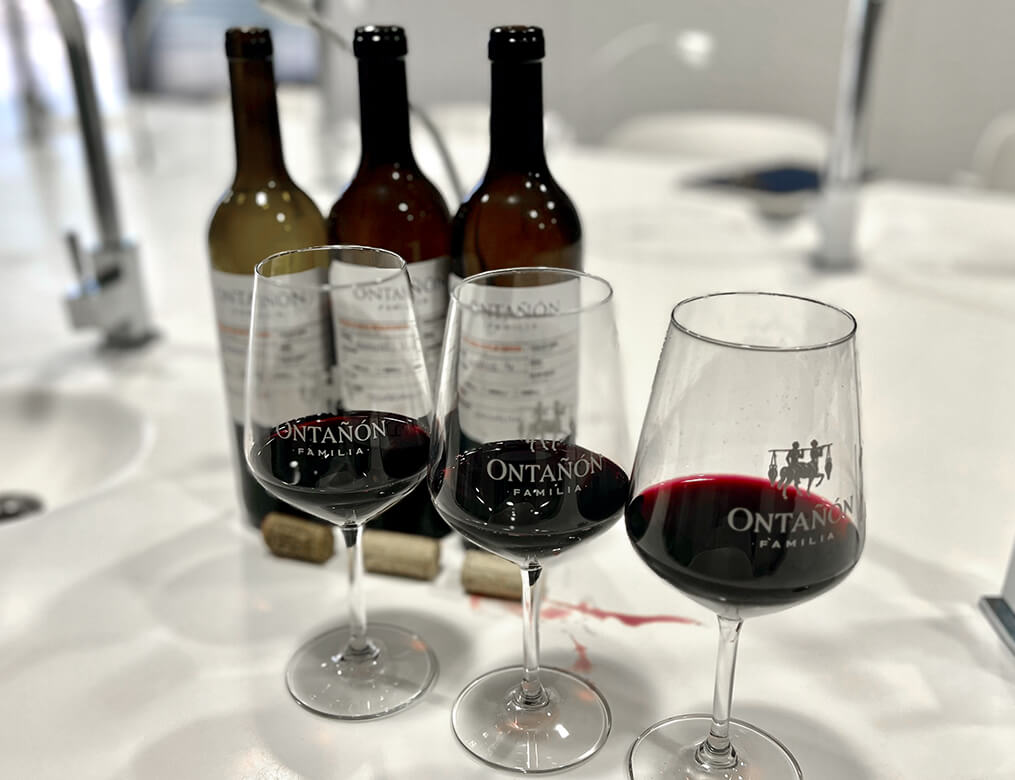
Tempranillo, Garnacha and Graciano wines from the Ensayos Capitales nº π.
The aim of the classical ‘coupages’ of blended Rioja wines is to give the fine mix greater ageing potential, through the addition of percentages of the different varieties which provide characteristics to offer the finished wine more acidity, structure, depth, richness and complexity of aromas. In the vast majority of cases, before making the blend, each variety is vinified separately, that is, it is fermented on its own, with the appropriate time and rhythms of each grape family. Once the finished wines are obtained, a specific amount of wine is extracted from each vat and is mixed in different test tubes in order to achieve the desired result. The person responsible for this ‘coupage’ needs to fully understand in depth the characteristics of each type of wine so that, thanks to their sensitivity, knowledge, experience and intuition, they can achieve the deeply desired balance between fruit, acidity and wood. These great oenologists have been crucial in the history of Rioja and are known as the masters of the mixture, total and easily recognised master blenders, who demonstrated incredible knowledge of each vineyard and the behaviour of the variety over the years.
In Ensayos Capitales nº π the blend of the varieties is completely different to a traditional ‘coupage’, since we use an innovative and until now unprecedented technique. Let’s see what it’s about. The Queirón Viticulture and Oenology teams have selected three characteristic Rioja grape varieties for their ampelographic tradition and their historical involvement in the blends of the great Rioja wines. Three varieties that we cultivate in Quel and from which we make various wines from the winery’s catalogue.
Tasting notes
We have found many fruit sensations and a roundness associated with garnacha and a lot of elegance, finesse and even notes of liquorice which are so typical of the tempranillo variety.
Color: Ensayos Capitales nº π is a clear, radiant wine with a deep robe. It has an intense, black-cherry colour with purple glints at the rim denoting its youthfulness.
Aroma: On the nose it is open, with powerful aromas of dark fruit, such as blueberries and blackberries; there are also notable red-berried fruit like cherries and raspberries, a floral component with hints of violet sweets and spicy nuances of black pepper and liquorice typical of the three varieties. In addition, it reveals a balsamic, herbal side with mineral notes coming through, all perfectly amalgamated with the toasted notes, cloves and coconut provided by the time spent ageing in mixed French- and American-oak casks, creating a complex and fascinating bouquet.
Sabor: It has a full-bodied, rounded, long, fine mouth-feel, with a pleasant attack and at the same time very meaty and harmoniously balanced. The mid palate reveals its tannins, like a succulent wine, with balanced acidity to give it a certain touch of freshness.
vintage
Technical data
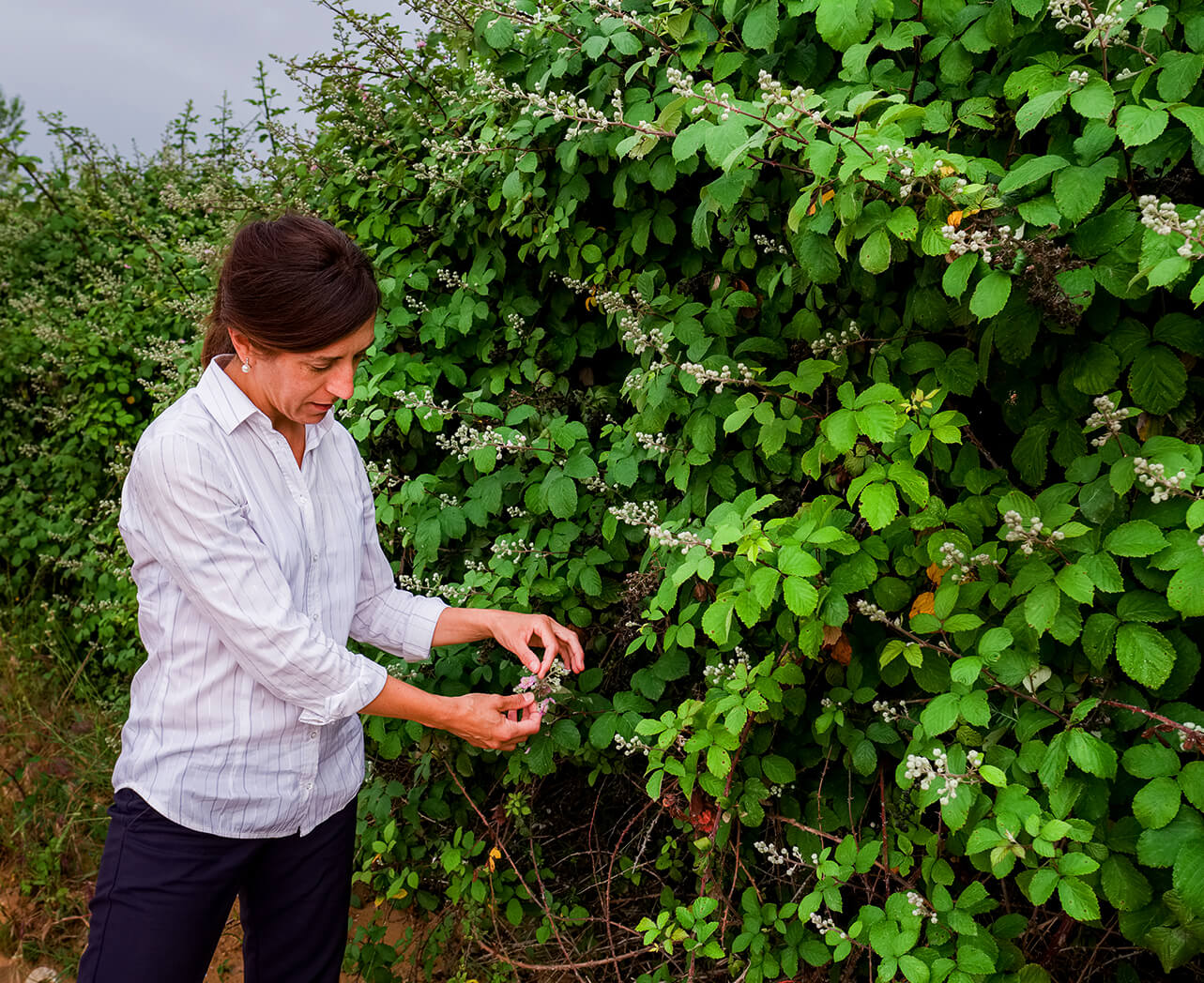
Leticia Pérez Cuevas, head of Viticulture at Queirón.
1. The pursuit
of perfect ripeness in each of the chosen varieties
One of the biggest challenges of this experiment was to have the three varieties at their peak moment of ripeness in each case, with the differences that they present with respect to all their values. To achieve this, the Queirón field team would make regular, methodical checks of various graciano, garnacha and tempranillo vineyards in different locations, altitudes and exposures, exhaustively assessing the ripeness of each of them, in order to then finally decide the key moment when each variety reached optimum ripeness for harvesting. This was possibly the most complicated goal of the experiment, finding the optimum point of ripeness in all three varieties at the peak of the growing cycle of each one of them.
The vineyards finally chosen to be part of Ensayos Capitales nº π were as follows:
- Graciano / El Pozo. In Quel (650 metres).
- Tempranillo / La Encina. In Quel (680 metres).
- Garnacha / El Balcón. In Quel (550 metres).
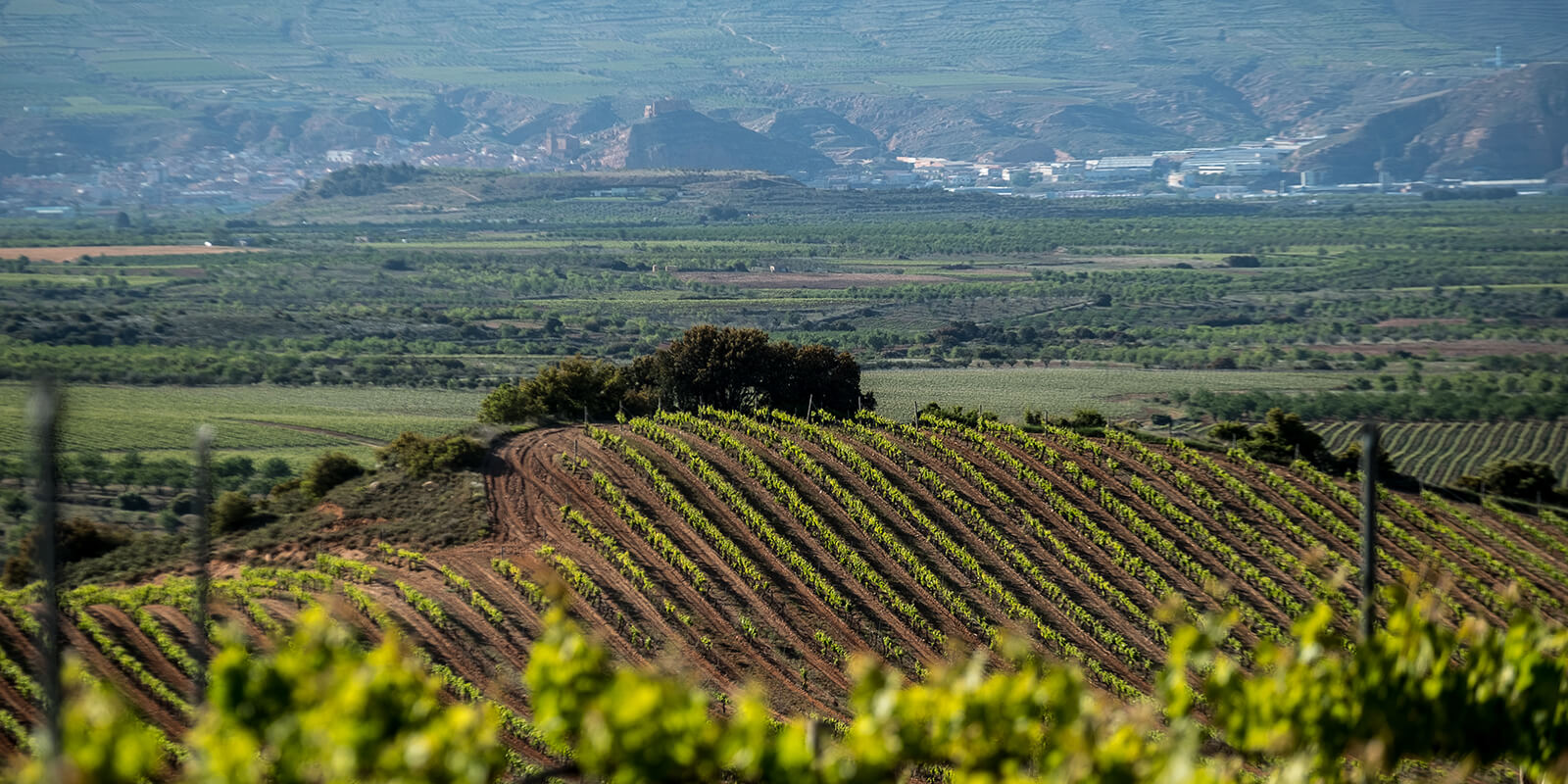
The Graciano vineyard, El Pozo, in the Sierra de Yerga.
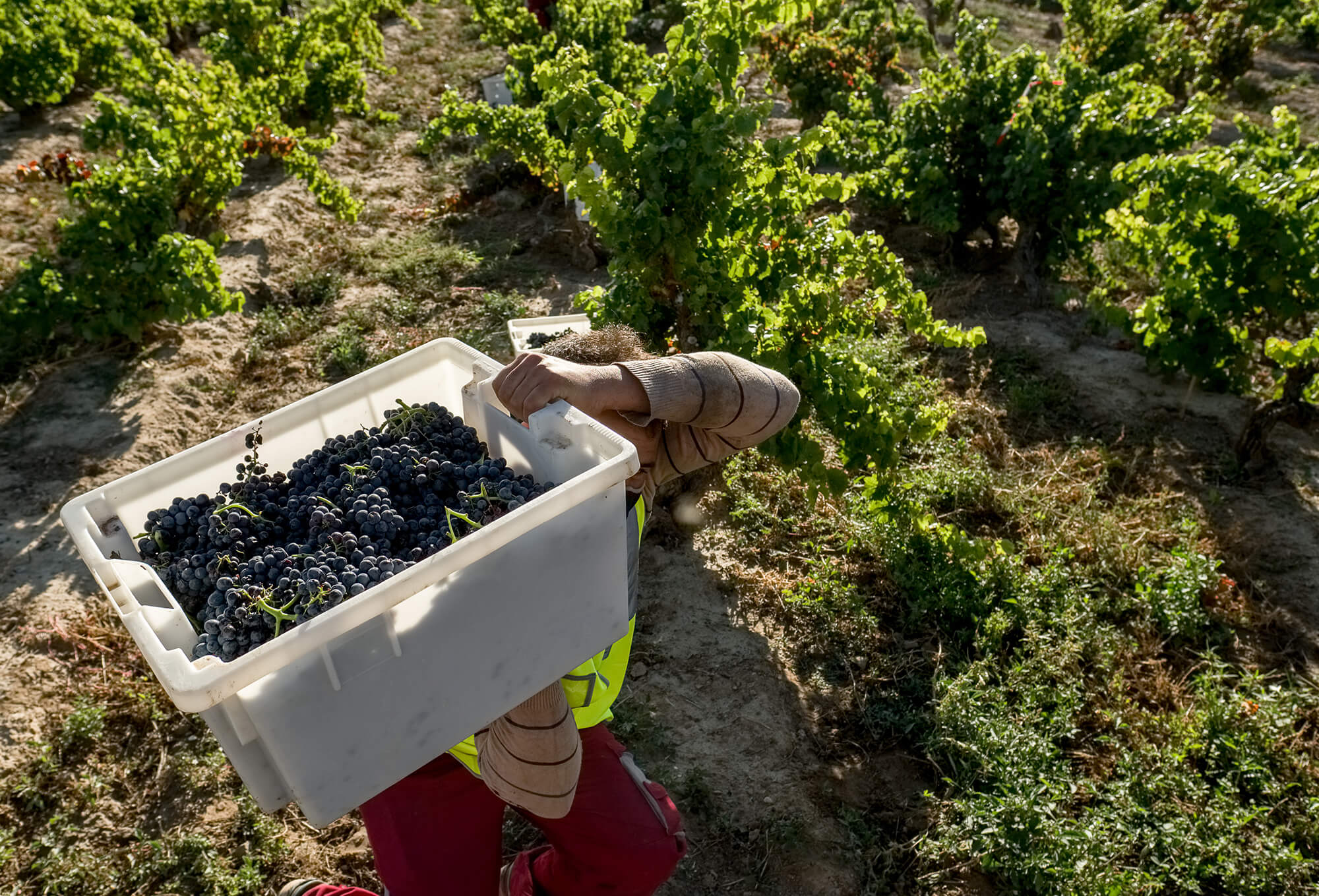
A moment of the harvest in one of the Quel vineyards.
2. Harvest
Fourth of October 2022
Once the date for harvesting was decided, the three vineyards were manually harvested on 4 October and the grapes taken to the Queirón winery in 200-kilo crates called ‘palots’. The grapes were sorted at three levels. The first in the vineyard itself (by only picking perfect clusters), the second at cluster level on the sorting table and finally, berry by berry. The wines were fermented in open vats, each variety separately. Pumping over was conducted using the technique of punching down the cap.
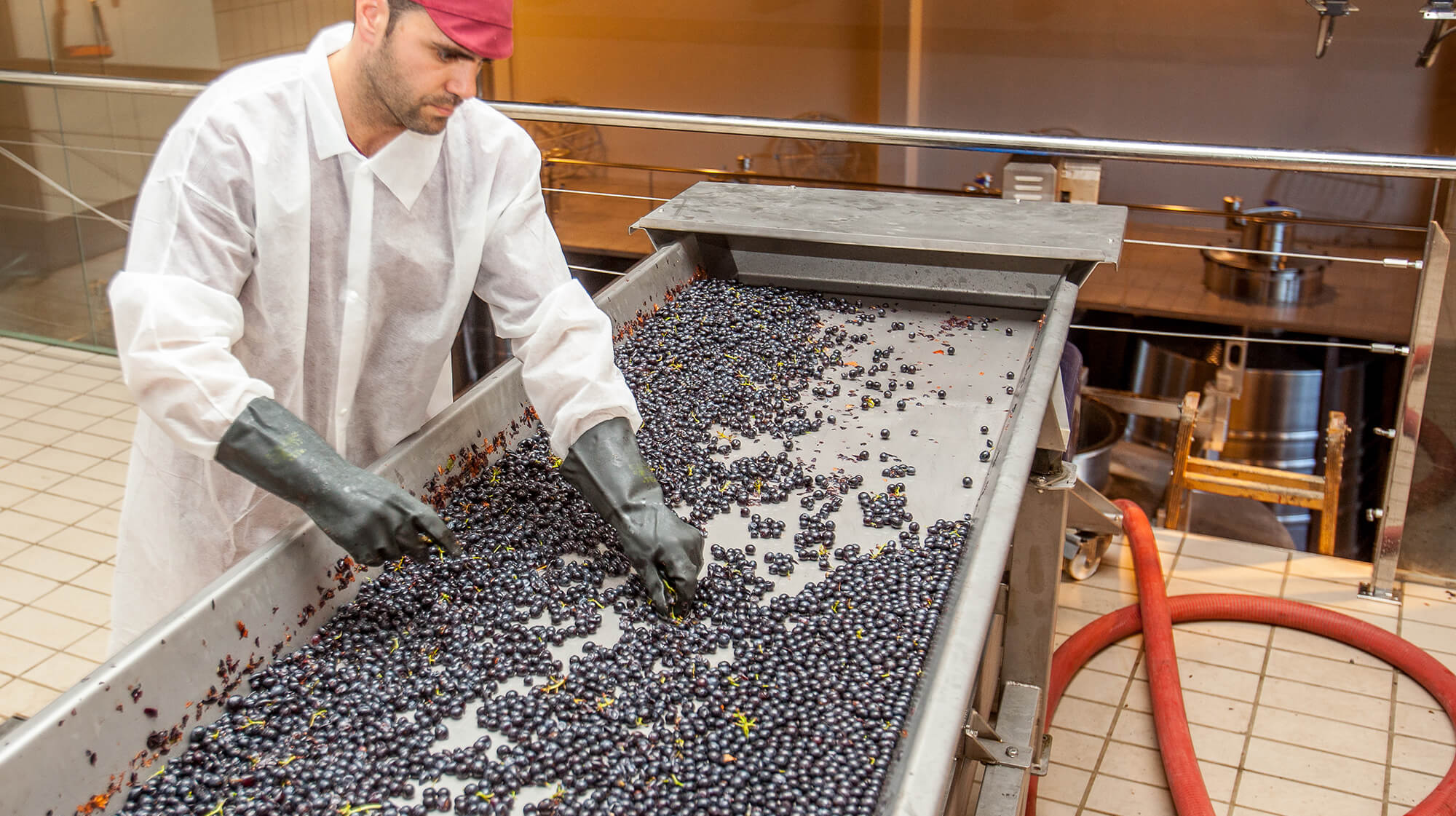
Table selection of Graciano grapes, before vatting.
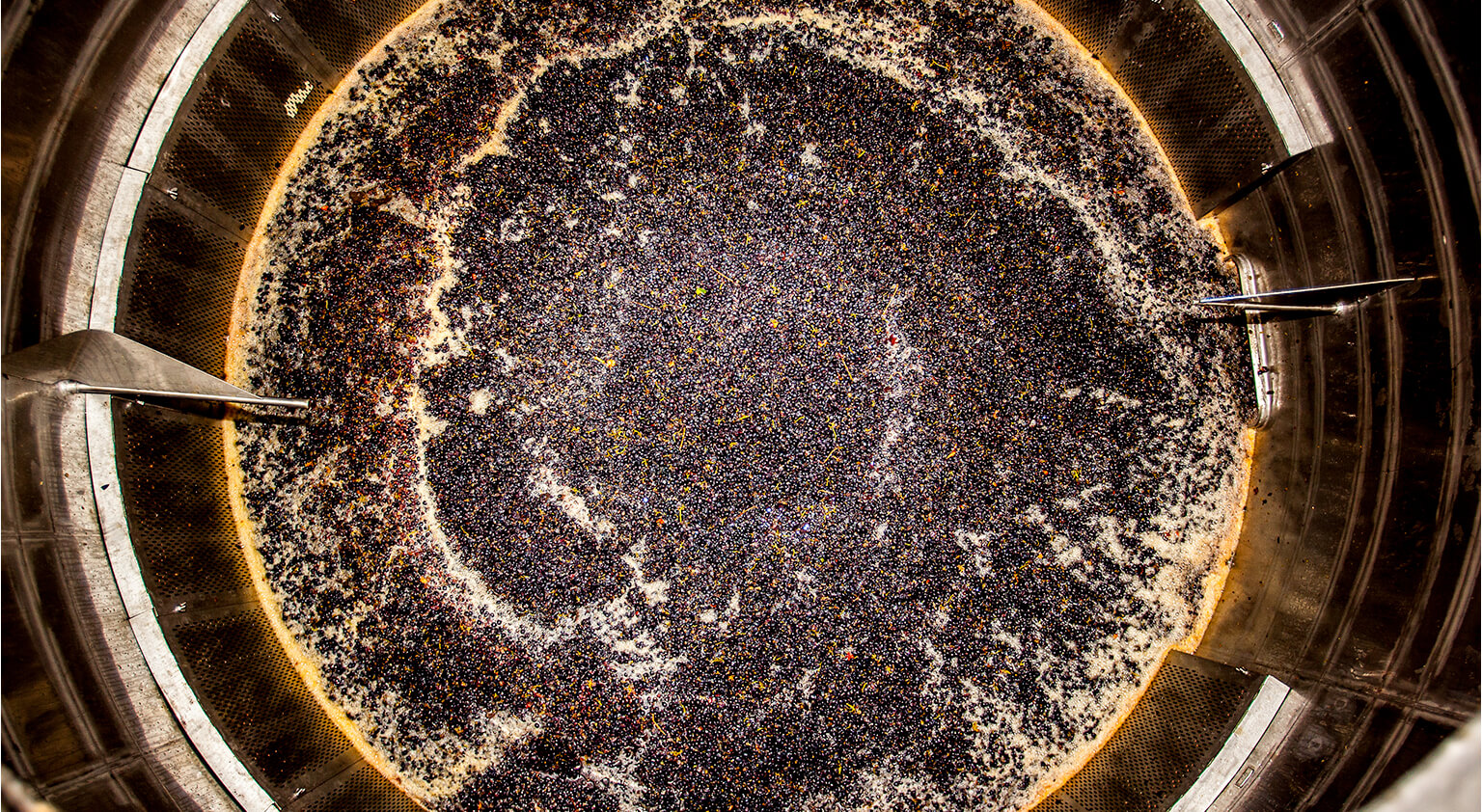
Beginning of the formation of the Graciano hat.
3. Vinification
Cold pre-fermentative maceration and start of alcoholic fermentation (duration six days)
All the varieties were cold-macerated for three days and alcoholic fermentation started simultaneously in the three separate vats. Each must remained in contact with the skins of its variety for six days.
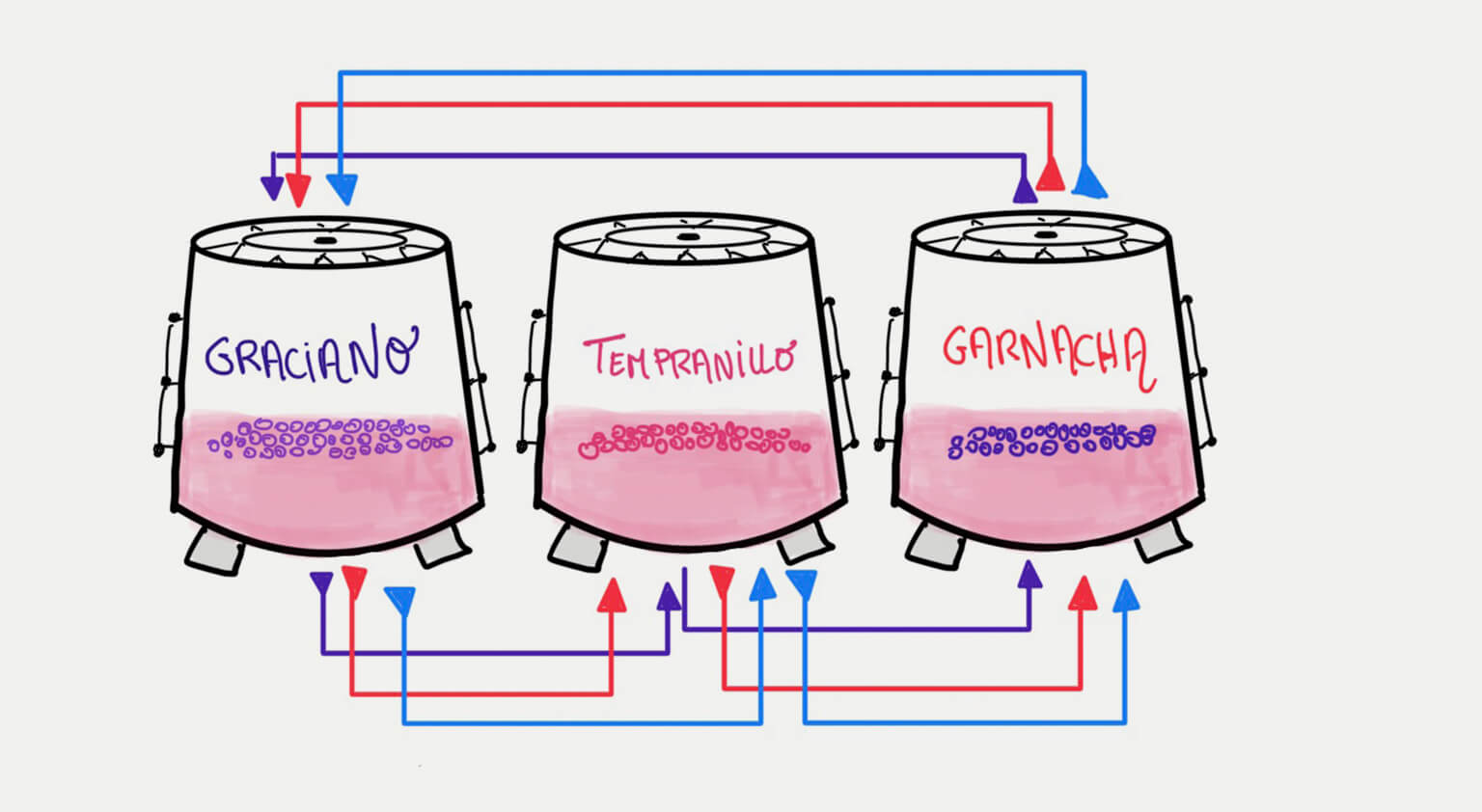
Diagram of the must – skins exchanges.
Fermentation with three caps
Each variety underwent part of its fermentation with its own skins and with the caps formed by the skins of the other two varieties. That is to say, the graciano must passed via the tempranillo cap and afterwards, via tat of the garnacha, before finishing up with its own. The must of each of these three varieties fermented in contact with three lots of skins: its own and those of the other two varieties at different stages of the process.
A) First must-skins exchange
(3 days)
When the density reading reached 030, the three vats were bled.
- The must from the graciano was added onto the cap of the tempranillo.
- The must of the tempranillo was added onto the cap of the garnacha.
- The must of the garnacha was added onto the cap of the graciano.
B) Second must-skins exchange
(2 days)
When the density reading reached 1010, the three vats were again bled.
- The must of the graciano –which was on the cap of the tempranillo- was added to the garnacha.
- The must of the tempranillo –which was on the cap of the garnacha- was added to the graciano.
- The must of the garnacha –which was on the cap of the graciano- was added to the tempranillo.
C) Third must-skins exchange
(7 days)
- The must of the graciano – which was on the cap of the garnacha- passed to its own skins.
- The must of the tempranillo – which was on the cap of the graciano- passed to its own skins.
- The must of the garnacha – which was on the cap of the tempranillo – passed to its own skins.
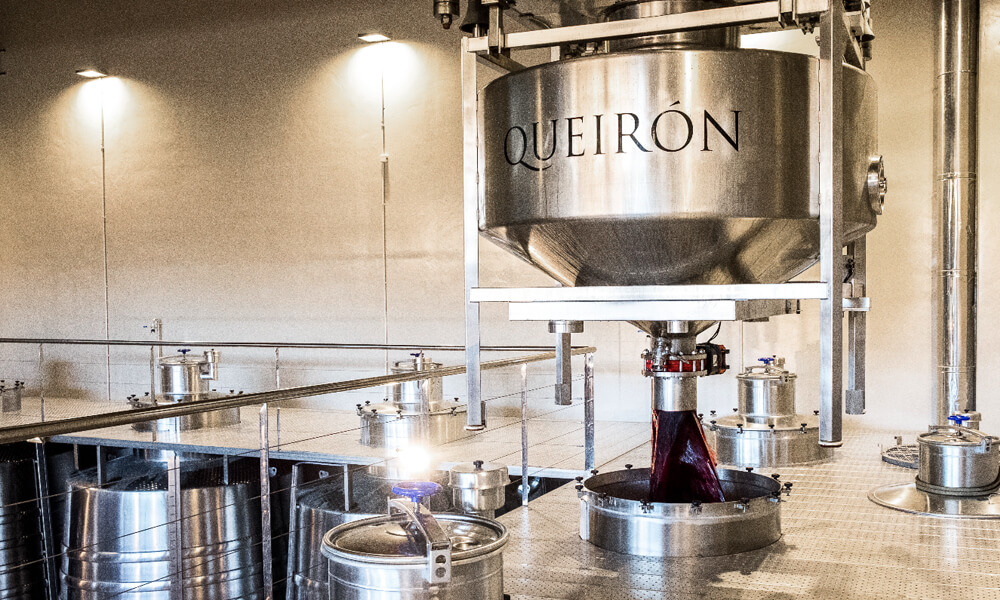
Pumping over and exchanging must-skins in the production hall
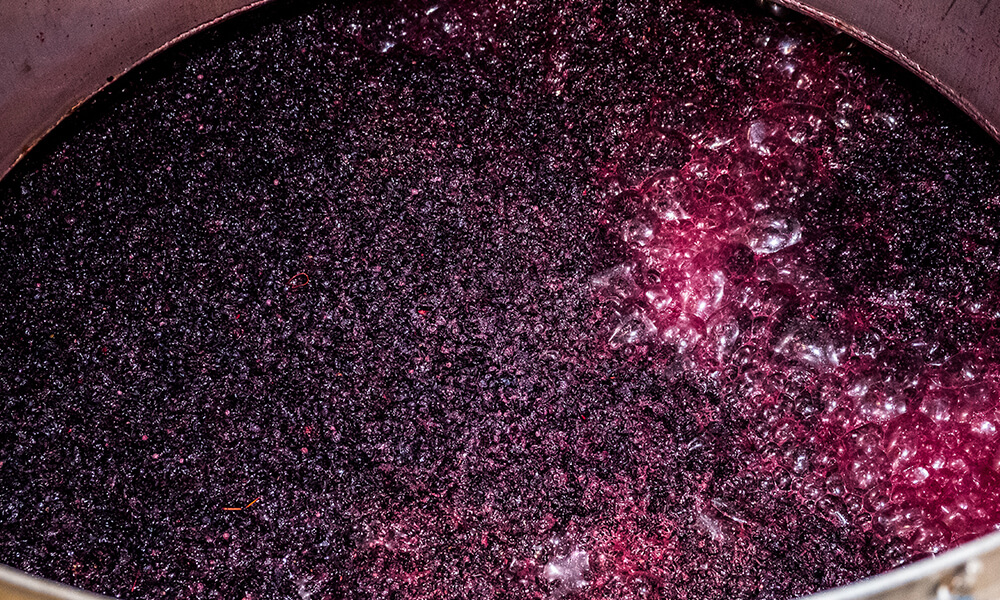
Graciano hat in the fermentation phase.
Malolactic Fermentation
Once alcoholic fermentation was complete, the wines were racked into mixed French- and American-oak casks being used for the second vintage and underwent their malolactic fermentation.
Aging in mixed barrels for twelve months
Once malolactic fermentation was complete, the wines were aged for seven months in mixed French- and American-oak casks being used for the second vintage.
General ideas of the fermentation with “sombrero de tres picos”
- In total, the fermentation process lasted 18 days.
- For the first six days, each must remained in contact with the cap formed by its own skins.
- After the first exchange, the graciano must spent three days with the tempranillo skins. Then it spent two days with the garnacha skins and finally, seven further days with its own skins, which in turn had spent a total of five days in contact with the tempranillo and garnacha musts.
- This means that 27 per cent of the graciano fermentative cycle took place with the skins of the other two varieties. And exactly the same happened in the case of the tempranillo and garnacha musts.
The oenological basis of this “coupage” and what we were looking for with Ensayos Capitales nº π
The starting point was the three varieties. Three essential grape families in the history of Rioja wines, each with its distinct and, at the same time complementary, characteristics.
Graciano originates in Rioja and is almost exclusively grown in our Designation of Origin. It is a variety with a long growing cycle and which in the highland district of the Sierra Yerga offers regular, satisfactory ripening. We obtain deeply coloured wines, with acidity and not the slightest hint of green character. This grape produces very aromatic wines, which will last for a long time and has traditionally been used in the tempranillo blends to provide extra acidity and colour. The best gracianos are those that have a reminder of dark fruit and spices, as well as lovely, subtle floral and herbal notes.
Tempranillo, also indigenous to Rioja, provides elegance, acidity, tannicity, long life and a great capacity for ageing. It is cultivated in a wide range of different climate conditions, however, in our zone, where there is a high altitude and a large thermal break between day and night temperatures, it has amazing potential. Very suitable wines for ageing, with ripe fruit ranging from blackberries, blackcurrants and certain hints of liquorice. This variety has been used as the backbone of almost all the wines, using the largest percentage in the different blends. Moreover, it is versatile and allows for different kinds of production methods depending on the type of wine we want. For example, it can be used in carbonic maceration, where it produces very fragrant, easy-to-drink wines, or with very long maceration processes, where the amount of tannin increases making the wines ideal for long ageing.
Garnacha is one of the most widely used black grapes in the world. It is a late ripening variety which needs hot, dry conditions to show off its greatest potential. It is a grape which gives the wines high alcoholic strength, a lot of fruit aromas, even jammy fruit. However, it is a variety in which the yield needs to be kept in check to ensure the best results. In Rioja it is used in blends to give the wines more alcoholic strength, sweetness, finesse and roundness.
And the result:
The amazing complexity of the graciano
The wine that the Queirón oenology team have chosen for this experiment was the one made from the Graciano grape variety (there are also wines in which the principle must used was of the other two varieties). The reason for this choice is that it offers an amazing sensation of aromatic complexity, in which the characteristics of the Graciano are present in a perfectly recognisable way, but in which there is a distinct difference due to the appearance of singular features of the other two grapes: tempranillo and garnacha.

Rubén Pérez Cuevas, in front of the Quel castle in the Queirón winery.
Mi Lugar
2019
Alegoría de Quel
El Arca
2020
Un viaje ancestral
Queirón de Gabriel
2011
El sueño de Gabriel
Ensayos Capitales Nº1
2018
Desafíos en el límite
Ensayos Capitales Nº2
2019
Lágrima en tinaja
_tempranillo_en_altura
Ensayos Capitales Nº3
2020
Asoleao

